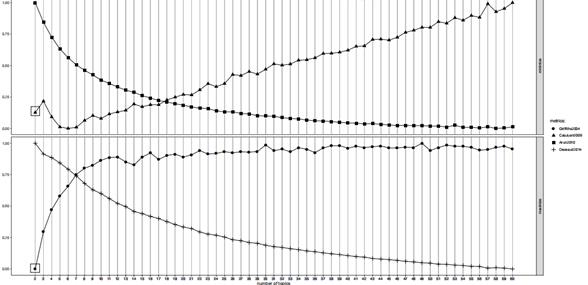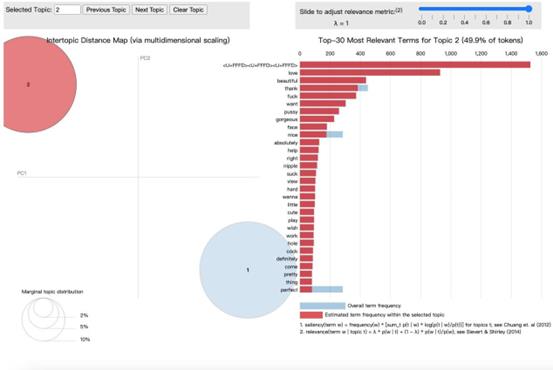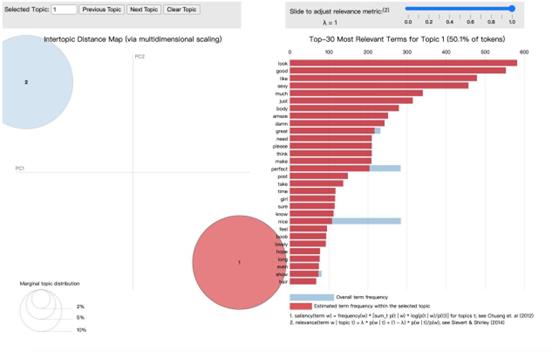1.Introduction
Firstly, what kinds of behaviors can be considered as suggestive behaviors?
Suggestive behaviors are generally defined as highlighting the curves of the female body, exposing shoulders, chest, navel, back, legs. Clothing with suggestive elements such as black stockings, fishnet stockings, etc. are often worn. The dance styles also often involve twisting the waist and other body parts, such as belly dancing, Japanese and Korean jazz dance, etc. However, their dances do not have any intention to showcase the dance itself, and most of them are behaviors that showcase body curves and seduce viewers [1].
Secondly, why can suggestive behavior attract more traffic? Why can't other behaviors do the same? Can't men do it as well?
Suggestive behavior has become a popular trend in the online live streaming industry, especially among female streamers. One reason for this is that it appeals to the male audience's desire for sexual stimulation and arousal [2]. Additionally, it is a way for female streamers to stand out and gain more attention in a highly competitive market [3]. While other behaviors such as gaming, singing, and dancing can also attract traffic, they cannot be as effective in capturing the attention of viewers as suggestive behavior [4]. This is because suggestive behavior taps into a primal instinct and desire for sexual attraction, which is a powerful motivator for many viewers [3]. Furthermore, it is not limited to female streamers. Male streamers can also engage in suggestive behavior to attract a female audience. However, the prevalence of suggestive behavior among female streamers is much higher, as it is often seen as a way to monetize their appearance and sexuality. Put another way, women become the suppliers of sex, whereas men constitute the demand for it and play the role of purchasers and consumers [2].
Finally, why can live streaming and short videos become the way for female streamers to engage in suggestive behavior? Can't other ways work?
Live streaming and short videos allow for a greater degree of anonymity and distance between the streamer and the viewer, which can make it easier for female streamers to engage in suggestive behavior without feeling judged or stigmatized [5]. Additionally, live streaming and short videos provide a sense of immediacy and intimacy that other forms of media may not be able to replicate [6]. By utilizing a series of strategies such as emotional conversion [6], female streamers achieve a return on emotional labor in the form of material rewards and receive labor compensation. In order to achieve long-term traffic development, bloggers have to provide feedback to their audience on both material and spiritual levels, satisfying the audience's higher-level emotional needs.
Overall, this article aims to provide a comprehensive and critical analysis of the traffic’s abruptly increase caused by the sexual suggestive behavior of female anchors on Chinese social media. A better understanding of the challenges and opportunities of online streaming in modern-day China can be explored by examining the complicated social, cultural, and economic factors that lead to this phenomenon.
2.Literature Review
2.1.Analysis of Video Live Broadcast Phenomenon of Network Female Anchors under the Perspective of Consumerism
With the rise of live-streaming and video-sharing platforms, sexually suggestive behavior by female anchors has become increasingly common. This paper aims to analyze this phenomenon and its impact on the network broadcasting industry from the perspective of consumerism.
This paper has repeatedly emphasized consumerism and its role in the live streaming industry. For example, consumerism encourages the commodification of personal relationships and emotions in the live streaming industry, which leads to the objectification of female anchors and the normalization of sexuality. In addition, the research literature in this paper shows that sexually suggestive behavior can attract more traffic, which leads to higher income for female anchors. However, due to the continuation of gender stereotypes and the strengthening of ideological persecution of women, such as gender stereotyping, this phenomenon has been criticized and opposed by most people.
When it comes to the ethical and moral aspects designed by this phenomenon, supriseingly, gender stereotyping is not mostly happened to men, but to women's elders or peers. In the methods involved in this paper, we can find that qualitative research methods are adopted, such as in-depth content analysis and network ethnographic research on female anchors' live broadcasts and short videos, and the emphasis is placed on the strategies of female anchors' use of suggestive behaviors, as well as the impact of these behaviors on viewers' emotional responses and consumption behaviors. At the same time, understanding the intention of female anchor's suggestive behavior from the perspective of consumerism can more clearly highlight why sexual suggestive behavior is so common to women.
In conclusion, by analyzing the strategies adopted by female anchors and the impact of such behaviors on the audience, deeper meaning of this phenomenon will be more clear and provide theoretical support for our forthcoming research.
2.2.Make Ambiguous——Who Shaped the Network Anchor Woman Image?
The research of this paper emphasizes the role of media and social norms in shaping the image of female anchors, that is, the media will habitantly portray female anchors as sexual objects, and continue gender stereotypes and strengthen harmful ideas about women, which are not the images of female anchors. In the subsequent research, this paper analyzes the reasons for this situation. Gender stereotypes and general norms of sex may have contributed to this phenomenon. For example, women who engage in suggestive sexual behavior may be judged and stigmatized by society, leading them to acquiesce in these attitudes, and perpetuating the image of sexy female anchors. All these factors add up to the social face and social image of female anchors today.
This study mainly studied the factors of the formation and continuation of the sexy female anchor image. By analyzing the media and social norms that shape this image and their impact on the industry and society, this paper provides profound and ethical insights on this phenomenon, and also provides a lot of information on the formulation of moral codes and regulations in the live broadcasting industry. And this is going to help a lot with the research.
2.3.Sexual Economics: Sex as Female Resource for Social Exchange in Heterosexual Interactions
This paper mainly analyzes the concept of sex economics and its application in heterosexual communication. Specifically, this paper explores the role of sex as a resource of social exchange for women and the implications of this phenomenon. The concept of sexual economics proposes that "sex is a resource that women possess and can be exchanged for other resources, such as money, status, protection, etc." The theory is that women have more control over their sexuality than men do and can use sex as a means of obtaining resources." In addition, studies have shown that women are criticized and stigmatized by society for engaging in the sex industry, while men are praised and praised for their sexual behavior. This bipolar phenomenon is very likely to result in the deepening of gender stereotypes and the perpetuation of female stigma.
By understanding the concept of sexual economics and its impact on gender relations and social attitudes towards women, this study analyzes the ethical implications and insights of the phenomenon of describing sex as a female resource for social exchange, and provides guidance for the development of ethical norms and social norms of male-female interaction. Finally, the article points out that there are some unusual comments on the Internet about sex economics. That is, when discussing sex economics, the competition between women and women is also an important discussion direction. For example: if we apply sexual competition between women and women to market relationships, we find that women not only view sex as a commodity, but also its attraction as an important resource for women.
In conclusion, this paper will provide considerable help for this subsequent paper on the relationship between sexually suggestive behavior and sexual economics and the stakes between the two.
2.4.Competing for Love: Applying Sexual Economics Theory to Mating Contests
The concept of sexual economic theory has attracted considerable attention in the field of psychology in the evolution of species. The theory could explain human mating behavior by studying how individuals compete for limited resources, such as sexual partners. "Mating competition is a widespread phenomenon in the animal kingdom, and humans are no exception." "The theory of sexual economics holds that individuals conduct cost-benefit analysis when choosing a mate. The analysis was influenced by factors such as physical attractiveness, social status and resources. The theory is that individuals with more resources have more bargaining power in the mating market and can therefore attract more desirable partners."
This paper mainly discusses the application of sexual economics theory in human mating competition. Through this information we can find that sexual economics in human mating competition indispensable role, but this is still a part of the theoretical lack, that is, why human mating competition can be related to sexual economics, without exception, the article discussed that: "Mating competition is a common strategy used by individuals to compete for mates. These competitions can take many forms, such as physical contests or displays of wealth and status." Studies have shown that more physically attractive people with higher social status are more likely to win mating competitions, which is why the application of sexual economics is relevant here.”
When it comes to how these unrelated events relate to our paper, this important piece of information in the paper can be a good resource: "The outcome of mating competition is not always predictable." The results can be influenced by factors such as the preferences of potential partners, the competitive environment and the strategies employed by competitors. For example, individuals may resort to deceptive tactics, such as lying about their resources or physical attractiveness, to gain a competitive advantage." In this way, the complex reason for the neutral suggestion behavior in this paper has a good explanation.
2.5.Physical Performance of Network Female Anchors and Social Communication
"With the rise of livestreaming platforms, a new phenomenon has emerged -- female online anchors who use their bodies as a means of entertainment and socializing."
This paper mainly explores the relationship between the physical representation of female network anchors and social communication, that is, female network anchors often use their bodies as a means to attract and retain viewers. This can take many forms, such as provocative clothing, provocative poses, and sexual innuendo. These physical performances are often accompanied by interaction with the audience, such as responding to comments and requests, and female anchors take this opportunity to exchange interests and build emotional relationships with the audience.
In addition, research has shown that the physical performance of female network anchors has both positive and negative effects on social interaction. On the one hand, it can increase user engagement and interaction, thereby creating a sense of community and social support. On the other hand, it can reinforce gender stereotypes and objectify women, leading to negative social consequences.For example, the physical performance of female anchors is also affected by cultural norms, audience expectations and personal motivations: some female anchors may use their bodies as a means of empowerment and self-expression, while others may be pressured by peer competition and industry trends to passively conform to social expectations of beauty and sex.
"The physical representation of female network anchors is a complex phenomenon that has both positive and negative effects on social communication." While it can increase audience engagement and interaction, it can also reinforce gender stereotypes and objectify women." The article also expects to conduct further research on the factors that affect the physical performance of female network anchors and promote positive social interaction. We hope to find out the deep-seated reasons and social status quo behind the strategy of female live broadcasting to create interest relationship and emotional bridge with the audience through physical performance, and provide more theoretical support for the core section of our article
3.Method
The research participants were bloggers with sex suggestion on the short video platform. Because Douyin is a very hot short video software in China, the above users are highly activated and can accurately reflect the research results. 5 female net celebrities, with the least 450,000 fans, and the most 1.72 million fans, are be choosed for the resembles, which reflects the universal laws of female net celebrities in different fans, which are representative.
First, significantly, determine if videos with sexual suggestive content lead to an increase in traffic would be a important thing. This research selected 1 representative female bloggers who did not have sexual suggestive content in her early videos but now do, and compared whether the sexual suggestion has brought her more traffic through the three factors of the number of likes, comments, and collection. The blogger called “Zhao Zhao Yun Duan Yue”(672,000 fans) from Douyin platform, in her early short videos, she was wearing jeans, sweaters and sneakers, but the traffic of her early video was very low which the likes of her single video were all under five thousand. But when she put on stockings, a short skirt and high heels, and made some sexually suggestive gestures, her video likes suddenly exceeded 100,000 or even reached 200,000 even though her looks haven't changed at all. The following table presents the changes in the amount of likes, comments and collection quantities of the four videos before and after. This shows that videos with sexually suggestive content are more likely to get more traffic.

Figure 1: Straightly Comparison from Screenshots
Table 1: Data and Information Comparison before and after adding Sexual Suggestiveness Behavior
Time |
likes |
comments |
collection |
wear |
2022-10-8 |
3183 |
91 |
503 |
sweatshirts, jeans, leather shoes |
2023-2-28 |
4888 |
112 |
532 |
Denim jacket, sports pants, sports shoes |
2023-5-31 |
132,000 |
4,370 |
18,000 |
stockings, short skirts, high heels |
2023-7-27 |
287,000 |
7,007 |
37,000 |
stockings, short skirts, high heels |
Additionally, determine five female bloggers who have recently released videos with sexual suggestive content. Each blogger selects a newly released video to collect ten comments below ten videos, using "word cloud" to find high-frequency words in these comments, and bring them into the context to analyze the audience behind the high-frequency words.
In this research, 5 bloggers from the Douyin platform(their usernames are Lingdang, Xiao mi feng, Xi zhi lang, Chen xi ya Thea and Beng dai)are selected. We use the high-frequency words displayed by word cloud to present the following.

Figure 2: Word Frequency Plot
In the last and most important step, due to the few data in the previous research can't support this theory entirely, more data are required, this way, 10,000 pieces of new data are modeled by using a handy tool called “MDCOR”.

Figure 3: MDCOR User Interface Platform.
MDCOR is a tool that removes the burden of manual classification and the impact of computer programming expertise [7]. By importing the acquired data into MDCOR, MDCOR can conduct rapid cleaning and mining, obtain the word frequency of the imported documents, and display the 20 words with the highest word frequency. Then, after screening the word frequency patterns, it will provide us with a metric graph. (see figure 3)


Figure 4: Text Mining/Cleaning and Top 20 Most Frequent Words.
Then, after screening the word frequency patterns, it will provide a metric graph. Finally, after obtaining the number of topics suitable for our data from the metric graph, the number of topics which suitable for our data can be clear out from the metric graph.(see figure 5)

Figure 5: MDCOR Assessment Metrics Showing the Convergence of Two Metrics
Then select the number of topics of our choice in MDCOR, and finally click Run. In the end, MDCOR will provide us with all the data about the modeling of our topic and provide considerable help in the research

Figure 6: Rationale Code and Word Selection in the Interactive Summary

Figure 7: Rationale Code and Word Selection in the Interactive Summary
4.Result
Before conducting the research, the data preprocessing can show that most people are very supportive of sexual innuendo behavior, and only a few people would criticize such behavior. Therefore, above evidence can speculate that sexual innuendo behavior can indeed increase traffic. And the fact seems to be just as previous reports.
Firstly, from the comparison of the number of likes and comments before and after adding sexual innuendo behavior in the same video content of a single blogger that, apart from the inherent seductive factor of the dance itself, the sexual innuendo behavior in clothing can indeed bring a considerable amount of traffic to the blogger, even nearly 40 times than before (fig.1), making the number of fans of this blogger skyrocket after several videos. This phenomenon is not accidental, even after several consecutive videos with more seductive clothing, the same is true. There are multiple growth of data, like the video at 2023-5-18 and 2023-2-8, the number of likes and comments increased by 8,000 and 4,000 respectively (Table.1) about Therefore, we can assume that sexual innuendo behavior can indeed bring traffic, and there is an important connection between the two. However, explaining it solely from clothing is too simple and not enough to bring very favorable evidence for our research.
Therefore, a word cloud analysis of the comments in the comment section of several blogger videos was concluded, which again proved that the hypothesis was correct. From the word cloud analysis, the most frequently appearing expressions in the comment section are "like" and "Tears" (fig.2), which directly express the audience's emotions. Don't forget that our research subject is in Chinese social media, and in Chinese social media, the "Tears" represents the meaning of love but cannot get the corresponding object. However, immediately following is "doubt" (fig.4), which shows that the cautious character of Chinese people also plays a significant role when they make comments.
Lastly, but most importantly, our big data modeling once again proved our hypothesis. The words "love" and "good" (fig.6&7) occupy the top two places in word frequency, and even when expect to find the frequency of opposing comments, any cannot be find in the top 20. In the final theme modeling, only very few opposing words in either of the two themes. This phenomenon once again proves our hypothesis.
5.Discussion
The purpose of this research is to understand how to view the growth in traffic caused by sexual suggestive behavior of women on Chinese social media. The main questions on research is the audience's attitude towards these sexual suggestive videos and why the audience responds to these videos. After deleting some meaningless common words, after screening the high -frequency words in the comments under the sexual suggestive video through Word Cloud and used MDCOR for Topic Modeling to artificially analyze the reasons for the final identification. In the study, by comparing the traffic of the same blogger before and after adding the content of sexual suggestion, the sexual suggestion can indeed increase the flow of short video. Through artificial analysis of the high -frequency words extracted from Word Cloud, most people's comment on sexual suggestion of is positive. They praised those women's beauty and sexy, and they were not ashamed to express their love for these videos. However, there were still a few comments showing the question of doubt. In the topic modeling, the words "love" and "good" (fig.6&7) occupy the top two places in word frequency, this confirms that the reason why people watch these videos is appreciating and loving these women.
There are varying views and opinions in existing academic literature regarding the sexual suggestive behavior of female online broadcasters. Some studies suggest that such behavior may have negative effects on viewers, particularly on the sexual attitudes and behaviors of young people. These studies recommend stronger regulation and management of female online broadcasters to protect the health and rights of viewers.
On the other hand, some academic literature suggests that sexual suggestive behavior of female online broadcasters is a form of artistic expression or performance art. These studies argue that broadcasters have the right to decide how they want to perform, and viewers have the right to choose whether or not to watch such content.
However, there are also many shortcomings in this study. The research objects selected by this study are single, all of which come from the Douyin platform. Therefore, in the future research, more sources can be increased to enhance the representativeness of the research objects. Secondly, there are fewer documents for reference in this study, because there are few research on topics in the world, so there are not many reference documents.
Live streaming has indeed opened up a new way for social activities beyond reality. With the support of new media technology, female broadcasters on live streaming platforms establish a new type of social relationship with male fans who have voyeuristic desires through body performances. This new type of social relationship can effectively bring female broadcasters or video bloggers a large amount of traffic and fans, which can bring them considerable income and benefits in many current policies. However, one concern that is the commodification of women's values is likely to occur. Perhaps symbolizing women's values is indeed the resources and opportunities that women strive for, but from the data we have collected, all bloggers with similar behaviors are abundant, but the comments are mostly similar. Believeing that such behavior can indeed bring women a lot of traffic and possible income in the short term, but in the long run, the audience is likely to experience aesthetic fatigue, and this sudden success will soon disappear. Most bloggers or female broadcasters who use such behavior as their main source of income will become lukewarm after reaching their peak for a period of time, and the gradual rationalization of the audience will also reduce consumption on such behaviors. Therefore, that such behavior will become the main means and trend for women in market competitionare not adviseable, also more women will engage in such behavior because it may bring considerable income cannot bring the society a positive effect. Hopingthat the phenomenon of the commodification of women's values will not increase, and the women can find more opportunities to replace the market competitiveness occupied by sexual suggestive behavior.
6.Conclusion
Firstly, one perspective is to view the growth in traffic caused by sexual suggestive behavior of women on Chinese social media as a reflection of changing consumer demands. Social media platforms are driven by user engagement, and using sexually suggestive behaviors to engage audiences is a proven marketing strategy. From this perspective, growth in traffic can be seen as a natural consequence of market forces.
Second, another point of view is that the increase in traffic from sexual suggestion by women on Chinese social media is a sign of a greater social problem. Utilization hints to attract audiences, strengthen negative stereotypes for women, and make gender inequality permanently. From this perspective, the growth of traffic can be regarded as a harmful consequence of a patriarchal society.
The third point of view is that the growth of traffic caused by female sexual suggestion on Chinese social media is a complex problem, and a detailed method is needed. Although it is important to recognize that this behavior on the negative impact of society, it is also important to understand the motivation and experience of women participating in it. From this perspective, the increase in traffic flow can be regarded as a complex result of various social, economic and cultural factors.
From the personal point of view, traffic growth caused by sexually suggestive behavior by women on Chinese social media is a complex issue that requires a nuanced approach. While it is important to regulate and manage the use of sexually suggestive behavior to engage audiences, it is also important to recognize the agency and autonomy of the women who engage in it. In addition, it is important to promote women's activism and empowerment in the media and address the root causes of gender inequality in society.
In conclusion, traffic growth caused by sexually suggestive behavior by women on Chinese social media is a complex and controversial issue requiring multifaceted solutions. By recognizing different perspectives on this issue and engaging in constructive dialogue, we can work towards creating a more inclusive and respectful society that values the dignity and rights of all individuals.
Acknowledgement
Wenzhe Li and Jun Zhang contributed equally to this work and should be considered co-first authors.
References
[1]. González Canché, M. S. (2023). Machine Driven Classification of Open-ended Responses (MDCOR): An analytic framework and no-code, free software application to classify longitudinal and cross-sectional text responses in survey and Social Media Research. Expert Systems with Applications, 215, 119265. https://doi.org/10.1016/j.eswa.2022.119265
[2]. Shengwu Liao, Yongtao Zheng. Analysis on the phenomenon of live video broadcast by network female anchors from the perspective of consumerism [J]. XINWEN AIHAOZHE 2022(04).
[3]. Yiguo Zeng. Network reporter, physical performance and social communication [J]. J Journal of Northwest Normal University (Social Sciences), 2018, 55 (1).
[4]. Longqian Cai. Emotional Operation in visual consumption: A case study of Webcast women [D]. Central China Normal University, 2018.
[5]. Ruiqi Liu. Creating ambiguity -- Who shaped the image of network female anchors? [D]. Zhejiang Normal University, 2019.
[6]. Baumeister, R. F., & Vohs, K. D. (2004). Sexual economics: Sex as female resource for social exchange in heterosexual interactions. Personality and Social Psychology Review, 8(4), 339–363. https://doi.org/10.1207/s15327957pspr0804_2
[7]. Baumeister, R. F., Reynolds, T., Winegard, B., & Vohs, K. D. (2017). Competing for love: Applying sexual economics theory to mating contests. Journal of Economic Psychology, 63, 230–241. https://doi.org/10.1016/j.joep.2017.07.009
Cite this article
Li,W.;Zhang,J. (2024). How to View the Traffic Growth Caused by Sexual Suggestive Behavior of Women on Chinese Social Media?. Communications in Humanities Research,29,214-224.
Data availability
The datasets used and/or analyzed during the current study will be available from the authors upon reasonable request.
Disclaimer/Publisher's Note
The statements, opinions and data contained in all publications are solely those of the individual author(s) and contributor(s) and not of EWA Publishing and/or the editor(s). EWA Publishing and/or the editor(s) disclaim responsibility for any injury to people or property resulting from any ideas, methods, instructions or products referred to in the content.
About volume
Volume title: Proceedings of the International Conference on Global Politics and Socio-Humanities
© 2024 by the author(s). Licensee EWA Publishing, Oxford, UK. This article is an open access article distributed under the terms and
conditions of the Creative Commons Attribution (CC BY) license. Authors who
publish this series agree to the following terms:
1. Authors retain copyright and grant the series right of first publication with the work simultaneously licensed under a Creative Commons
Attribution License that allows others to share the work with an acknowledgment of the work's authorship and initial publication in this
series.
2. Authors are able to enter into separate, additional contractual arrangements for the non-exclusive distribution of the series's published
version of the work (e.g., post it to an institutional repository or publish it in a book), with an acknowledgment of its initial
publication in this series.
3. Authors are permitted and encouraged to post their work online (e.g., in institutional repositories or on their website) prior to and
during the submission process, as it can lead to productive exchanges, as well as earlier and greater citation of published work (See
Open access policy for details).
References
[1]. González Canché, M. S. (2023). Machine Driven Classification of Open-ended Responses (MDCOR): An analytic framework and no-code, free software application to classify longitudinal and cross-sectional text responses in survey and Social Media Research. Expert Systems with Applications, 215, 119265. https://doi.org/10.1016/j.eswa.2022.119265
[2]. Shengwu Liao, Yongtao Zheng. Analysis on the phenomenon of live video broadcast by network female anchors from the perspective of consumerism [J]. XINWEN AIHAOZHE 2022(04).
[3]. Yiguo Zeng. Network reporter, physical performance and social communication [J]. J Journal of Northwest Normal University (Social Sciences), 2018, 55 (1).
[4]. Longqian Cai. Emotional Operation in visual consumption: A case study of Webcast women [D]. Central China Normal University, 2018.
[5]. Ruiqi Liu. Creating ambiguity -- Who shaped the image of network female anchors? [D]. Zhejiang Normal University, 2019.
[6]. Baumeister, R. F., & Vohs, K. D. (2004). Sexual economics: Sex as female resource for social exchange in heterosexual interactions. Personality and Social Psychology Review, 8(4), 339–363. https://doi.org/10.1207/s15327957pspr0804_2
[7]. Baumeister, R. F., Reynolds, T., Winegard, B., & Vohs, K. D. (2017). Competing for love: Applying sexual economics theory to mating contests. Journal of Economic Psychology, 63, 230–241. https://doi.org/10.1016/j.joep.2017.07.009









